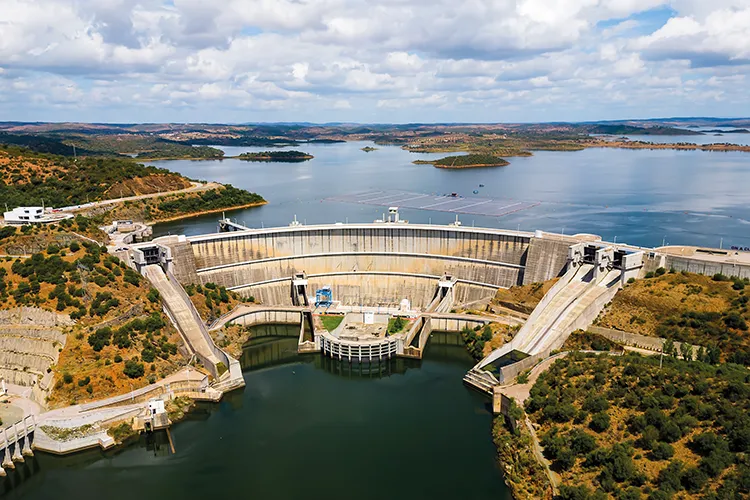
The Alqueva dam promised prosperity for Portugal’s parched south. Instead, it’s fuelling a corporate-driven monoculture that ecologists and farmers warn is destroying the land and the way of life that it sustained
By Marta Vidal, photographs by André Paxiuta
On a bright winter morning, Eva Barrocas watches over her sheep as they graze in the olive grove her grandparents planted decades ago in Ferreira do Alentejo, in southeastern Portugal. ‘Look, an eagle!’ she calls out, pointing to the clear sky. ‘And a black kite, and storks. This area has a lot of biodiversity,’ she adds as she counts the species she has spotted so far.
At Monte Guarda-Rios (Kingfisher’s Hill), Eva and her family produce organic olive oil and grow wheat and oats. Her sheep graze among the olive and holm oak trees scattered across the rolling hills of her family’s land in Alentejo, a southern region commonly known as the ‘breadbasket’ of Portugal. This traditional landscape, known as montado, is what is called an agro-silvopastoral system – one that integrates forestry with livestock and crops. It supports a vast diversity of wildlife, including the endangered Iberian lynx and the threatened imperial eagle.
But Alentejo’s mosaic of trees, pastures and agricultural land, which combines production and nature conservation, is increasingly under threat. Each year, Portugal loses an average of 5,000 hectares of montado, as trees die, land degrades and intensive farming encroaches on traditional agroforestry systems.
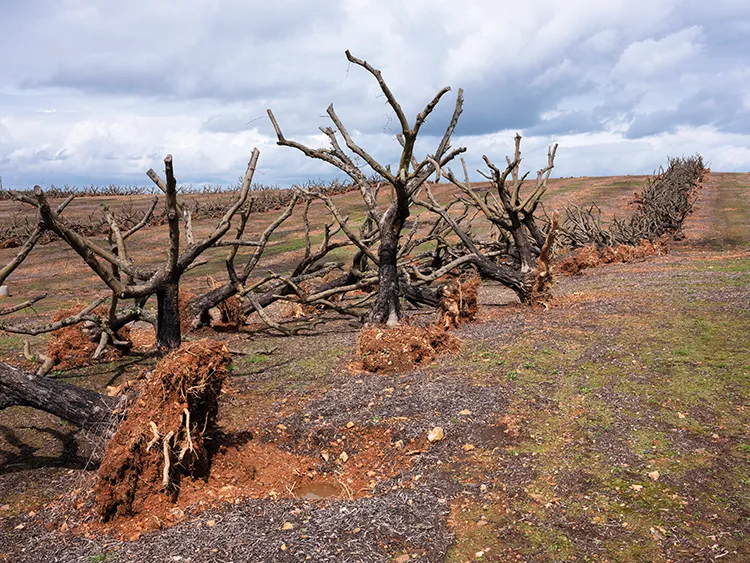
‘We are surrounded by super-intensive olive plantations. We are feeling more and more isolated,’ says Eva sombrely, as she points to her neighbour’s newly planted hedgerows. ‘We are seeing the impacts on biodiversity and the fragmentation of habitats.’
Irrigated olive plantations have expanded significantly in the last two decades, thanks to the supply of cheap water from Alqueva, a dam built on the Guadiana River. With a concrete wall that is nearly 100 metres high, the reservoir can hold 4,150 million cubic metres of water, making it the largest artificial lake in Western Europe.
Funded by the European Union and completed in 2002, the Alqueva dam was developed with promises it would bring economic growth to one of the continent’s poorest and driest areas. However, instead of helping small farmers maintain the region’s diverse montado and traditional olive groves, the irrigation system has mostly been to the benefit of large corporate groups and investment companies profiting from super-intensive olive plantations.
‘Here on the farm, we have no access to the water from Alqueva. It doesn’t reach everyone,’ says Eva, who grows rain-fed crops adapted to the dry region. As of 2024, the Alqueva irrigation system covers 127,800 hectares of Alentejo’s roughly two million hectares of agricultural land, representing only a small fraction of the region’s total farmland. According to EDIA, the public company managing Alqueva, around 80 per cent of the dam’s water is used to irrigate intensive olive and almond plantations. Last year, EDIA provided water to 74,059 hectares of olive plantations, of which about 70 per cent are super-intensive hedgerows.
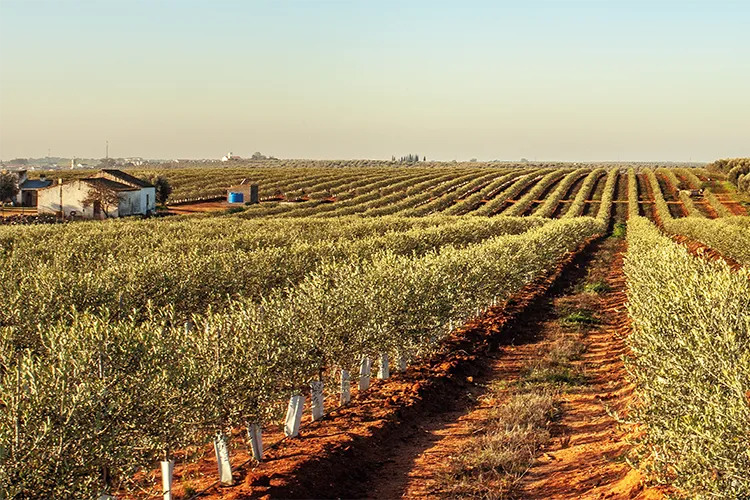
A few large companies manage the vast majority of the region’s irrigated land, such as Elaia, De Prado and Aggraria, some of the world’s biggest olive oil producers. Unable to compete with these big corporate groups, many small farmers have been forced to sell their land. In the last two decades, at least 70 per cent of agricultural land surrounding the Alqueva dam was sold, and the price of land increased fivefold.
Now, across Alentejo, row upon row of small, olive shrubs stretch to the horizon. Uprooted trees pile up by the side of the roads to make way for very high-density hedgerow plantations.
This system relies on highly productive dwarf varieties, such as arbequina, which are adapted to mechanisation. The small trees are planted close together in hedges, with about 2,000 per hectare. Planting, pruning and harvesting are mechanised, reducing the need for labour and achieving very high yields. But this system requires much more water and agrochemicals than traditional olive groves. Instead of living hundreds or even thousands of years, the trees last only a few decades and are more vulnerable to extreme weather and pests.
Over the years, Maria José Roxo, a professor of geography at Nova University in Lisbon, has seen trees being uprooted to establish irrigated plantations, then uprooted again to plant even more intensive ones. ‘We need to have mosaics, refuges for wildlife,’ says Roxo. Yet, she has witnessed the expansion of monoculture plantations that rely on irrigation, heavy machinery, pesticides and fertilisers, causing soil erosion and biodiversity loss.
For some, however, the uniform rows of olive hedges are what success looks like. ‘Portugal is now one of the world’s top exporters of olive oil,’ says Susana Sassetti, director of Olivum, an association of olive producers with about 50,000 hectares of olive plantations, most of them supplied with water from the Alqueva dam. In the last two decades, olive oil exports have increased 12 times in volume and 18 times in value. In 2022, olive oil exports reached more than €930 million, says Sassetti.
The intensification of olive oil production has been pushed by the EU’s Common Agricultural Policy incentives and a global rise in olive oil demand. Between 2007 and 2020, Portugal’s olive sector received about €1 billion in agricultural subsidies.
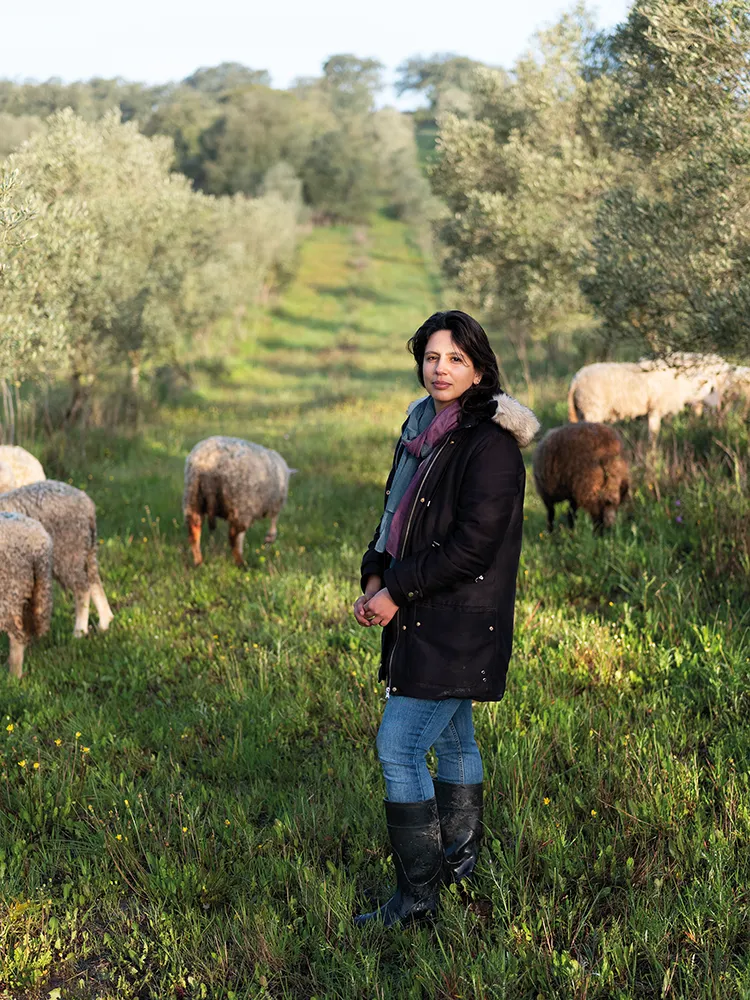
‘Olive plantations require less water than most other permanent crops and generate a lot of wealth,’ says José Pedro Salema, president of EDIA. Salema claims that irrigated olive plantations ‘can achieve unbeatable profitability. Today, we can have olive groves that are highly efficient with minimal environmental impact.’
EDIA plans to expand irrigation to supply an additional 47,000 hectares. However, as intensive plantations grow, concerns about the long-term consequences are also increasing. ‘I tested the water from our bore wells, and the nitrate levels were ten times higher than the safe levels,’ says Eva Barrocas, who sees this as evidence of the impact that her neighbours’ intensive olive plantations are having on the region’s shared resources. ‘We are seeing a lot of soil erosion here. There has been a lot of soil tilling to prepare for the new plantations and a lot of topsoil has been lost,’ she adds.
Roxo, a geographer specialising in desertification, is particularly concerned about the extensive soil run-off from olive plantations. ‘When it rains heavily, the Guadiana River and its tributaries become very muddy. The water is full of sediment, which means the soil has been destroyed. We are losing a resource that is extremely difficult to recover,’ she says.
Experts and environmentalists have warned that intensive olive farming in southern Portugal is turning a once diverse landscape into monotonous rows of intensive plantations, destroying ecosystems and contaminating water and soil with agrochemicals.
MONOCULTURE ECOCIDE
ZERO, one of Portugal’s leading environmental organisations, has denounced the unregulated expansion of monocultures in Alentejo as ‘ecocide’. Pedro Horta, ZERO’s policy officer, says Alqueva’s irrigation scheme has mostly benefited super-intensive olive and almond plantations, fostering big concentrations of property and a large-scale monoculture model ‘which has a clear impact on biodiversity’. According to ZERO, intensive farming in the Alqueva region has led to the disappearance of populations of the endangered plant species Linaria ricardoi and the total or partial destruction of at least 20 temporary Mediterranean ponds, priority habitats protected under national and European legislation. It has also contributed to the loss of habitats for steppe birds such as the great bustard, the lesser kestrel and the little bustard, which depend on open landscapes, as well as the destruction of riparian woodlands, and the degradation of montado, threatening endemic species.

A study on the olive industry published by EDIA revealed that intensive hedgerow plantations supported only about half of the species found in traditional olive groves, while researchers at the University of Jaén found that intensive olive plantations could lead to the loss of one out of four species of bird, ant and herb. Similarly, a study entitled ‘A Silent Mediterranean Spring’ highlighted how the shift toward super-intensive systems is greatly reducing diversity and simplifying bird communities in olive orchards.
The construction of the dam, a project first mooted by dictator António Salazar in the 1950s, also had a severe environmental impact. The vast concrete wall spanning the Guadiana Valley flooded an area of 25,000 hectares, resulting in the disappearance of ecosystems, the whitewashed village of Luz and dozens of archaeological sites, as well as the felling of more than one million trees. ‘An entire ecosystem was destroyed. It affected important habitats and several protected species, like the Iberian lynx,’ says João Joanaz de Melo, one of the founders of the environmental group GEOTA.
Enjoying this article? Check out our related reads:
The dam’s construction cost about €2.5 billion, funded by both the EU and the Portuguese government, making it the largest public investment made in agriculture in the country’s modern history. In addition to the initial construction expenses, there are ongoing costs for maintaining the infrastructure and pumping water to irrigated areas, many of which are located above the reservoir.
Controversy surrounds the price of water. ‘If we accounted for infrastructure costs, the price would be around 30 cents per cubic metre, but farmers are paying an average of only eight cents – a fraction of its true cost,’ says Joanaz de Melo. ‘I don’t think it’s reasonable to produce at such an artificially low price while degrading our most valuable resources: water and soil.’
EDIA’s president, José Pedro Salema, claims the company has environmental monitoring programmes and it has implemented a number of measures to support biodiversity, such as the management of green covers to protect the soil, the restoration of unproductive spaces on the plantations and the installation of bat shelter boxes. He argues the dam is strategically important to guarantee water supply in the region and has ‘brought a lot of economic benefits’, creating jobs and attracting investment.

However, highly mechanised intensive monoculture plantations largely rely on seasonal and poorly paid migrant labour. Despite promises that it would revitalise the region, the dam has failed to prevent the ongoing rural flight. Between 2011 and 2021, Alentejo lost more than 52,000 residents – the largest population decline in the country. All of the municipalities that benefit from water from the dam recorded population losses.
‘There is a worrying prevalence of investment companies, which aim to extract as much profit as possible before moving on,’ says Joanaz de Melo, who specialises in environmental impact assessment and sustainability. ‘This short-term greed is at odds with visions needed for the future.’
DROUGHT AND EXTREME WEATHER
As temperatures rise across Western Europe, Portugal is suffering from the driest climate it has experienced in at least 1,200 years. Experts and environmentalists are warning that the region’s intensive agricultural model is unsustainable in a climate increasingly affected by drought and extreme weather events.
A recent study by the consulting company Agrogés found that climate change will increase water requirements for olive groves by five to 21 per cent, while the average annual inflows to the Alqueva reservoir are expected to decrease by five to ten per cent by 2050, and by 15–30 per cent by 2080. The study highlights the fact that current irrigation allocations ‘are clearly insufficient to meet water needs’.

For geographer Maria José Roxo, the alarming scenario requires a different model for the region. ‘We need to think beyond short-term economic profitability,’ she says. ‘We need to consider how our resources can sustain our activities in the future. If we continue on this path without soil conservation practices and without preserving biodiversity, we will become even more vulnerable to desertification and climate change.’
The case for large dams has weakened in recent years due to growing awareness of their environmental impact and the effects of climate change. Rising temperatures increase evaporation from reservoirs, while large dams also release significant amounts of methane. An Oxford University study that evaluated 245 large dams concluded they are not cost-effective, with their actual costs nearly double the initial budgeted estimates.
Teresa Pinto Correia, a professor at the University of Évora who specialises in rural landscapes, argues that investing in small-scale irrigation would be more sustainable. Smaller dams could help preserve Alentejo’s mosaic of montado. ‘We are concentrating water use in a relatively small area, and it is benefiting mostly foreign investors,’ she says. ‘It doesn’t benefit the local population.’ The problem, she adds, is not just the concentration of land ownership and the unequal distribution of water, but also this model’s disconnection from the land. She argues that ‘this type of economic activity has no connection to the territory. It follows the logic of investment’ with no concern for long-term sustainability. ‘These companies prioritise their returns, but these investments come at the expense of our heritage and resources,’ she adds.
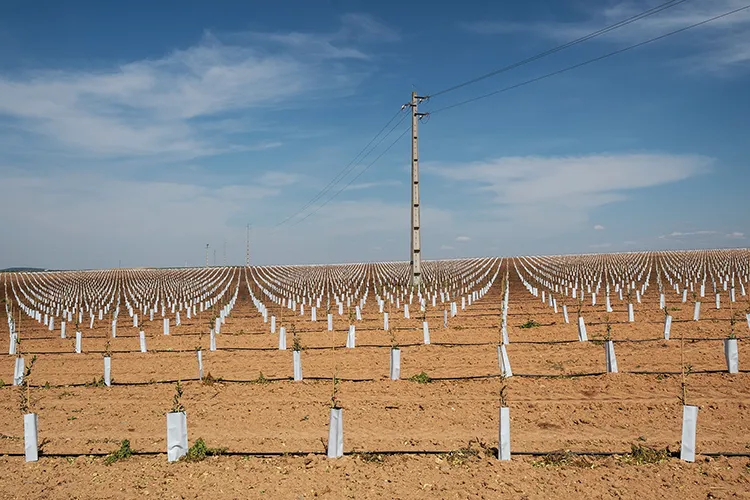
While traditional olive groves consist of trees that grow naturally in dry soil with deep roots and can live for hundreds, sometimes even thousands of years, trees in super-intensive plantations have shallow roots and last only a few decades. Eva Barrocas, who cares for the olive trees planted by her grandparents in Ferreira do Alentejo, sees the importance of long-term planning.
‘Super-intensive olive trees are planted to last 15 or 20 years. These companies are here to profit and then leave. The model on our farm is completely different. We focus on long-term agriculture that cares for the environment. We want to preserve ecosystem services and leave things better than we found them,’ she explains. ‘My olive grove may produce lower yields, but I know it will last. It will continue to support the future generations.’




